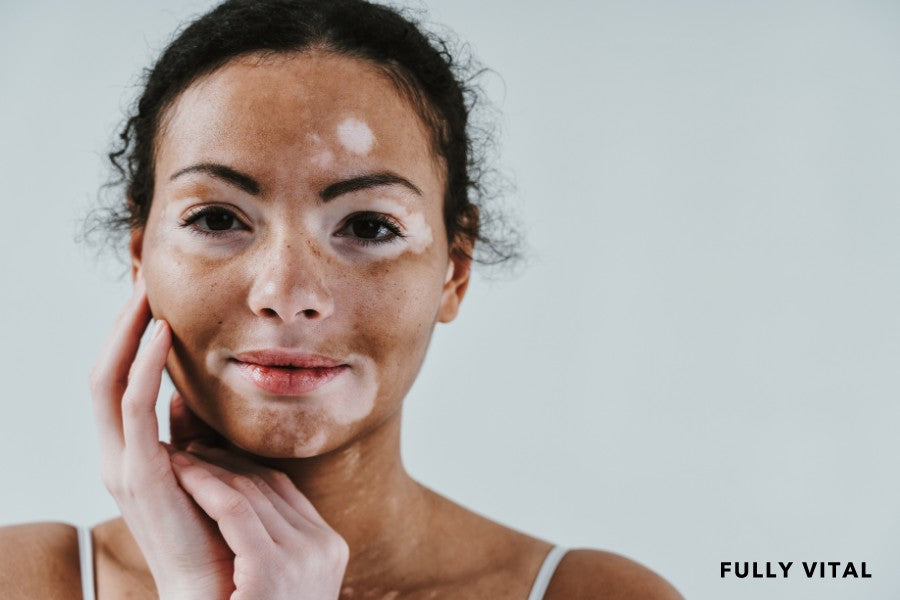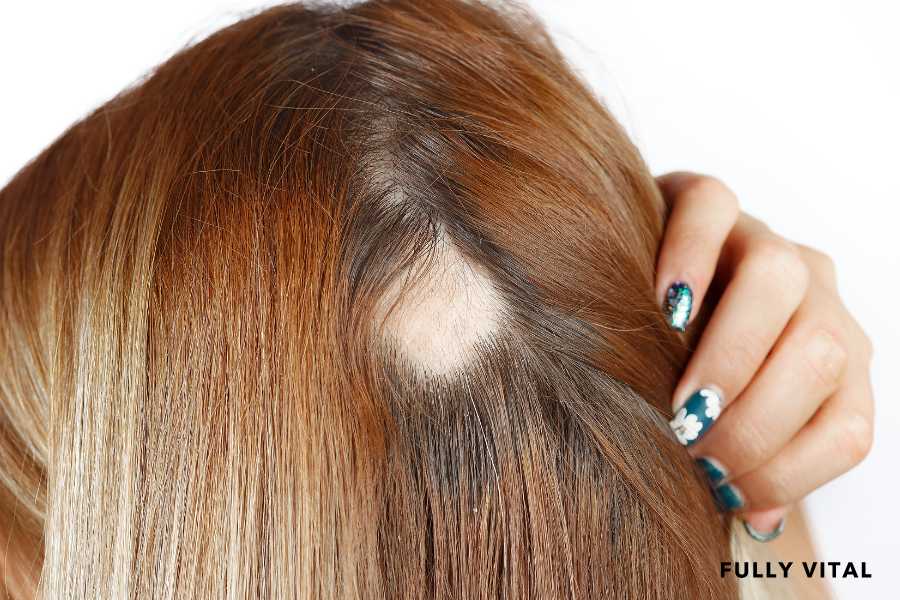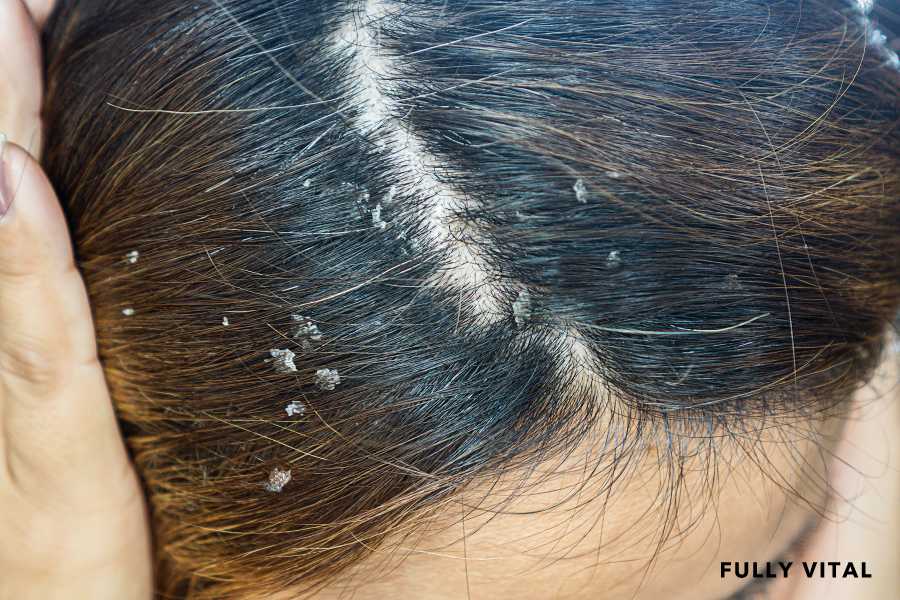
Understanding Vitiligo: Causes, Symptoms, And Treatment Options
Welcome to our comprehensive guide on understanding vitiligo.
In this article, we'll delve into the causes, symptoms, and various treatment options available for this skin condition.
If you're one of the many women seeking insights into hair growth and related concerns, gaining knowledge about vitiligo can broaden your understanding of skin health.

I LOVE MY HAIR NOW
FullyVital hair serum and hair vitamins made tremendous improvements in my hair. I truly love my hair now.
Dorit S.,
What Is Vitiligo?
Vitiligo is a skin condition characterized by the development of white or light-colored patches on the skin due to the loss of pigmentation.
This occurs when melanocytes, the cells responsible for producing skin color, either malfunction or are destroyed.
As a result, these depigmented patches can emerge on any part of the body and vary in size and shape.
While vitiligo itself is not physically harmful, its impact can extend beyond the skin's surface.
The noticeable change in skin color can have emotional and psychological implications, affecting an individual's self-esteem and body image.
These patches are commonly observed on areas with thinner skin, such as the face, hands, wrists, and around body openings.
Understanding vitiligo is crucial not only for recognizing its physical manifestation but also for addressing the broader aspects of its influence on an individual's well-being.1

Why Is Vitiligo Treatment Important?
Vitiligo treatment holds significant importance in addressing both the physical and emotional aspects of this skin condition.
Beyond its visible impact, vitiligo's influence on self-esteem and mental well-being can be profound.
Treatment plays a pivotal role in boosting self-confidence by restoring pigmentation and minimizing the noticeable contrast between depigmented patches and unaffected skin.
By alleviating emotional distress caused by changes in appearance, treatment empowers individuals to navigate their daily lives with greater positivity.2
Furthermore, effective vitiligo treatment contributes to an improved overall quality of life. Individuals who successfully manage their condition tend to engage more confidently in social interactions and experience psychological relief.
The restoration of pigmentation through treatment methods helps individuals feel more comfortable and at ease with their skin, thereby addressing aesthetic concerns and enhancing self-perception.
With a variety of treatment options available, each person can opt for an approach that aligns with their preferences and medical needs, ensuring a tailored and effective strategy.
How Does Vitiligo Develop And Progress?
Vitiligo develops when the body's immune system attacks and damages melanocytes.
While the exact cause is not fully understood, genetic factors and autoimmune responses are believed to play a role.
The condition can progress gradually or suddenly, with the rate of progression varying among individuals.
Factors like stress, sun exposure, and trauma can influence the development and progression of vitiligo.3
Benefits Of Vitiligo Treatment?
Vitiligo treatment offers a range of benefits for those affected:
Restored Pigmentation
Treatment methods aim to repigment the affected areas, resulting in a more even skin tone.
Enhanced Self-Confidence
By reducing the visible contrast between patches and normal skin, treatment can boost self-esteem.
Psychological Relief
Addressing the aesthetic concerns associated with vitiligo can provide emotional relief.
Tailored Approaches
Various treatment options allow individuals to choose what suits them best.
Improved Overall Well-Being
Successfully managing vitiligo can lead to an improved quality of life and better social interactions.
Alternatives To Vitiligo Treatment?
While considering alternatives to traditional treatment, it's important to manage expectations. Some alternatives include:
Cosmetic Solutions
Makeup and skin camouflage products can temporarily conceal vitiligo patches.
Sun Protection
Sunscreen is crucial, as sunburn can exacerbate the condition.
Support Networks
Joining support groups can offer emotional assistance and valuable coping strategies.
Camouflaging Techniques
Micropigmentation and tattooing can help conceal patches, although results may fade over time.
How Can I Prevent Vitiligo?
While there is no surefire way to prevent vitiligo, you can take steps to minimize its impact and promote overall skin health:
-
Sun Protection: Protect your skin from sunburn, which can worsen vitiligo. Use sunscreen with a high SPF and wear protective clothing.
-
Manage Stress: Stress may contribute to flare-ups. Practice relaxation techniques such as meditation or yoga.
-
Balanced Diet: A diet rich in antioxidants and nutrients can support skin health. Consume foods like fruits, vegetables, and whole grains.
-
Avoid Trauma: Prevent skin trauma or friction, as injuries can trigger new patches in susceptible individuals.
What Happens If Vitiligo Is Left Untreated?
If left untreated, vitiligo can result in:
-
Increased Depigmentation: Existing white patches may enlarge and new patches could develop over time.
-
Emotional Impact: The noticeable change in appearance can lead to self-esteem and psychological challenges.
-
Sun Sensitivity: Depigmented skin is more susceptible to sunburn and other sun-related issues.
-
Social Isolation: Negative perceptions from others might lead to social discomfort and isolation.
Our Best Sellers
Can Vitiligo Develop During Any Stage Of Life?
Certainly, vitiligo can develop during any stage of life, making it a condition that can affect individuals of all ages.
While it's often observed to begin before the age of 30, it is not restricted by age brackets.
The manifestation of vitiligo can occur during childhood, adolescence, adulthood, and even later stages of life.
The timing of its onset varies widely among individuals, and the factors influencing its appearance are multifaceted.
In childhood, vitiligo can sometimes be challenging to identify due to the absence of pigmentation in some areas.
Parents or caregivers might notice these patches during bath time or when their child has a tan.
Adolescent onset is also common, and the sudden appearance of white patches on visible areas like the face, hands, or neck can be emotionally impactful during this sensitive phase of life.
In adulthood, vitiligo can develop as a new condition or continue progressing from earlier stages.
The development of vitiligo is a complex interplay between genetic predisposition, autoimmune responses, and environmental triggers.
While genetic factors contribute to the risk of developing vitiligo, they do not solely determine whether an individual will have the condition.
Autoimmune responses play a significant role, wherein the body's immune system targets and attacks its own melanocytes, leading to the loss of pigmentation.
Environmental factors such as stress, sun exposure, and certain chemicals might trigger or exacerbate vitiligo in genetically susceptible individuals.
Is Vitiligo A Condition That Is Inherited?
Vitiligo has a genetic component, suggesting that there is some hereditary predisposition to the condition.
Individuals with a family history of vitiligo might have a slightly higher risk of developing it themselves.
However, the inheritance pattern is complex, and not everyone with a family history of vitiligo will necessarily develop the condition.
While genetics contribute to the risk, other factors such as autoimmune responses and environmental triggers also play significant roles in the onset of vitiligo.
Are There Different Types Of Vitiligo?
vitiligo is classified into different types based on its patterns and distribution:
-
Non-Segmental (Generalized) Vitiligo: This is the most common type, with symmetrical patches appearing on both sides of the body.
-
Segmental Vitiligo: This type usually affects one side or segment of the body and tends to occur at a younger age.
-
Localized (Focal) Vitiligo: A few small patches in one area characterize this type.
-
Universal Vitiligo: This rare type involves extensive depigmentation across the body.
Tracing The Historical Context Of Vitiligo: A Significant Aspect For Hair Growth
The history of vitiligo intertwines with the evolution of skincare and wellness practices, making it an essential topic for a Hair Growth Product Company.
Understanding the historical context sheds light on the challenges and perceptions surrounding skin conditions, and how they've shaped the way individuals approach self-care and overall well-being.
Historical Remedies
Throughout history, diverse cultures have explored remedies for skin conditions, often influenced by prevailing beliefs.
Stigma And Misconceptions
Vitiligo was once stigmatized and misunderstood, emphasizing the importance of accurate information and destigmatization efforts.
Empowering Progress
Over time, advancements in medical science and shifts in societal attitudes have empowered individuals to seek effective treatments and embrace diverse skin appearances.
The Current Landscape: Vitiligo's Role In The Modern Wellness Scenario
In today's wellness landscape, vitiligo holds a significant place, directly aligning with the core values of a Hair Growth Product Company.
Recognizing the current environment surrounding vitiligo highlights the interconnectedness of skin health, self-confidence, and holistic well-being.
-
Inclusive Self-Care: The modern wellness movement celebrates self-care practices that encompass physical, mental, and emotional aspects of well-being.
-
Skin Diversity: As society embraces diversity, conversations about vitiligo contribute to dismantling beauty standards and promoting inclusivity.
-
Empowerment Through Knowledge: Empowering individuals with accurate information about vitiligo fosters informed choices and proactive self-care.
Paving The Path For The Future: Vitiligo And Its Ongoing Impact
The future of vitiligo is marked by continuous progress, innovation, and collective efforts to redefine beauty norms and enhance well-being.
As a Hair Growth Product Company, addressing vitiligo's significance means embracing the ongoing journey of empowerment, support, and transformative change.
-
Advancements In Research: Ongoing research endeavors aim to uncover the intricacies of vitiligo, leading to more effective treatments and management strategies.
-
Societal Transformation: The future holds the promise of a more inclusive society that celebrates all skin appearances and challenges outdated perceptions.
-
Holistic Well-Being: Understanding vitiligo's role in the broader landscape of wellness reflects a commitment to holistic health, empowerment, and nurturing the relationship individuals have with their bodies.
Unlock the Secret to Youthful Hair with Fully Vital!Experience the transformative power of science-backed hair growth solutions. At Fully Vital, we're dedicated to redefining your hair's journey. Our innovative products are designed to:
Elevate your hair care routine and embark on a journey to reclaim your youthful locks. Join us in celebrating the harmony of science and beauty, right here at Fully Vital. |
Final Thoughts On Vitiligo
In conclusion, understanding vitiligo is crucial for individuals seeking comprehensive insights into skin health and well-being.
By recognizing its causes, symptoms, and treatment options, you're empowered to make informed decisions about managing this condition.
Vitiligo's impact goes beyond physical appearance, affecting emotional well-being as well. Remember, embracing your uniqueness and seeking support are essential steps on this journey.
As you continue to prioritize your overall health, consider exploring products that enhance your hair's vitality.
At Fully Vital, we're dedicated to helping you maintain a vibrant and healthy relationship with your locks.
Our range of hair growth products is designed to address hair aging, ensuring that you enjoy healthy, lustrous hair.
Embrace your individuality, empower yourself with knowledge, and take steps towards vibrant hair and skin health.
Frequently Asked Questions About Vitiligo
Is vitiligo a rare condition?
Vitiligo is not extremely common, but it affects people of various races and ethnicities.
Can vitiligo be spread through physical contact?
No, vitiligo is not contagious and cannot be spread through contact.
Are there factors that increase the risk of developing vitiligo?
Risk factors include family history, autoimmune disorders, and certain environmental factors.
Is vitiligo treatment suitable for everyone?
Treatment effectiveness varies, and it's advisable to consult a dermatologist for personalized guidance.
Can stress influence vitiligo?
Emotional stress and trauma can potentially trigger or worsen vitiligo in susceptible individuals.
Do natural remedies effectively treat vitiligo?
While some natural remedies are promoted, their efficacy lacks strong scientific support.
How does UV therapy factor into vitiligo treatment?
UV therapy, or phototherapy, can stimulate repigmentation in affected areas.
Is vitiligo hereditary?
There is a genetic predisposition to vitiligo, meaning a family history of the condition can increase the likelihood of developing it.
What are the early signs of vitiligo?
The early signs of vitiligo often include the appearance of white patches on the skin, which may gradually increase in size over time.
Are there specific areas of the body where vitiligo is more likely to occur?
Vitiligo can occur on any part of the body, but it commonly affects areas with thinner skin, such as the face, hands, wrists, and areas around body openings.
Sources:
-
Cleveland Clinic. (2016). Vitiligo of the Skin | Cleveland Clinic. Cleveland Clinic. https://my.clevelandclinic.org/health/diseases/12419-vitiligo
-
Grimes, P. E., & Miller, M. M. (2018). Vitiligo: Patient stories, self-esteem, and the psychological burden of disease. International Journal of Women’s Dermatology, 4(1), 32–37. https://doi.org/10.1016/j.ijwd.2017.11.005
-
Vitiligo: MedlinePlus Genetics. (2022, February 24). Medlineplus.gov. https://medlineplus.gov/genetics/condition/vitiligo/







